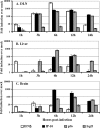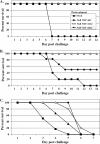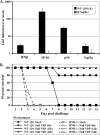Acute infection with venezuelan equine encephalitis virus replicon particles catalyzes a systemic antiviral state and protects from lethal virus challenge
- PMID: 19793821
- PMCID: PMC2786707
- DOI: 10.1128/JVI.00564-09
Acute infection with venezuelan equine encephalitis virus replicon particles catalyzes a systemic antiviral state and protects from lethal virus challenge
Abstract
The host innate immune response provides a critical first line of defense against invading pathogens, inducing an antiviral state to impede the spread of infection. While numerous studies have documented antiviral responses within actively infected tissues, few have described the earliest innate response induced systemically by infection. Here, utilizing Venezuelan equine encephalitis virus (VEE) replicon particles (VRP) to limit infection to the initially infected cells in vivo, a rapid activation of the antiviral response was demonstrated not only within the murine draining lymph node, where replication was confined, but also within distal tissues. In the liver and brain, expression of interferon-stimulated genes was detected by 1 to 3 h following VRP footpad inoculation, reaching peak expression of >100-fold over that in mock-infected animals. Moreover, mice receiving a VRP footpad inoculation 6, 12, or 24 h prior to an otherwise lethal VEE footpad challenge were completely protected from death, including a drastic reduction in challenge virus titers. VRP pretreatment also provided protection from intranasal VEE challenge and extended the average survival time following intracranial challenge. Signaling through the interferon receptor was necessary for antiviral gene induction and protection from VEE challenge. However, VRP pretreatment failed to protect mice from a heterologous, lethal challenge with vesicular stomatitis virus, yet conferred protection following challenge with influenza virus. Collectively, these results document a rapid modulation of the host innate response within hours of infection, capable of rapidly alerting the entire animal to pathogen invasion and leading to protection from viral disease.
Figures







Similar articles
-
Replicon-helper systems from attenuated Venezuelan equine encephalitis virus: expression of heterologous genes in vitro and immunization against heterologous pathogens in vivo.Virology. 1997 Dec 22;239(2):389-401. doi: 10.1006/viro.1997.8878. Virology. 1997. PMID: 9434729
-
Replicon particles of Venezuelan equine encephalitis virus as a reductionist murine model for encephalitis.J Virol. 2009 May;83(9):4275-86. doi: 10.1128/JVI.02383-08. Epub 2009 Feb 18. J Virol. 2009. PMID: 19225006 Free PMC article.
-
Infected dendritic cells are sufficient to mediate the adjuvant activity generated by Venezuelan equine encephalitis virus replicon particles.Vaccine. 2012 Jun 22;30(30):4532-42. doi: 10.1016/j.vaccine.2012.04.030. Epub 2012 Apr 21. Vaccine. 2012. PMID: 22531556 Free PMC article.
-
Development of a Broadly Accessible Venezuelan Equine Encephalitis Virus Replicon Particle Vaccine Platform.J Virol. 2018 May 14;92(11):e00027-18. doi: 10.1128/JVI.00027-18. Print 2018 Jun 1. J Virol. 2018. PMID: 29540599 Free PMC article.
-
Alphavirus replicon particles as candidate HIV vaccines.IUBMB Life. 2002 Apr-May;53(4-5):209-11. doi: 10.1080/15216540212657. IUBMB Life. 2002. PMID: 12120997 Review.
Cited by
-
Immunogenicity and efficacy of alphavirus-derived replicon vaccines for respiratory syncytial virus and human metapneumovirus in nonhuman primates.Vaccine. 2016 Feb 10;34(7):950-6. doi: 10.1016/j.vaccine.2015.12.045. Epub 2016 Jan 7. Vaccine. 2016. PMID: 26772634 Free PMC article.
-
Antiviral Effects of Novel Herbal Medicine KIOM-C, on Diverse Viruses.PLoS One. 2015 May 5;10(5):e0125357. doi: 10.1371/journal.pone.0125357. eCollection 2015. PLoS One. 2015. PMID: 25942440 Free PMC article.
-
Alphavirus-based replicons demonstrate different interactions with host cells and can be optimized to increase protein expression.J Virol. 2023 Nov 30;97(11):e0122523. doi: 10.1128/jvi.01225-23. Epub 2023 Oct 25. J Virol. 2023. PMID: 37877718 Free PMC article.
-
Treatment with cationic liposome-DNA complexes (CLDCs) protects mice from lethal Western equine encephalitis virus (WEEV) challenge.Antiviral Res. 2010 Aug;87(2):195-203. doi: 10.1016/j.antiviral.2010.04.013. Epub 2010 May 7. Antiviral Res. 2010. PMID: 20452378 Free PMC article.
-
Enhancement of protein expression by alphavirus replicons by designing self-replicating subgenomic RNAs.Proc Natl Acad Sci U S A. 2014 Jul 22;111(29):10708-13. doi: 10.1073/pnas.1408677111. Epub 2014 Jul 7. Proc Natl Acad Sci U S A. 2014. PMID: 25002490 Free PMC article.
References
-
- Alsharifi, M., M. Regner, R. Blanden, M. Lobigs, E. Lee, A. Koskinen, and A. Mullbacher. 2006. Exhaustion of type I interferon response following an acute viral infection. J. Immunol. 177:3235-3241. - PubMed
-
- Anishchenko, M., S. Paessler, I. P. Greene, P. V. Aguilar, A.-S. Carrara, and S. C. Weaver. 2004. Generation and characterization of closely related epizootic and enzootic infectious cDNA clones for studying interferon sensitivity and emergence mechanisms of Venezuelan equine encephalitis virus. J. Virol. 78:1-8. - PMC - PubMed
-
- Aronson, J. F., F. B. Grieder, N. L. Davis, P. C. Charles, T. Knott, K. Brown, and R. E. Johnston. 2000. A single-site mutant and revertants arising in vivo define early steps in the pathogenesis of Venezuelan equine encephalitis virus. Virology 270:111-123. - PubMed
-
- Barna, M., T. Komatsu, Z. Bi, and C. S. Reiss. 1996. Sex differences in susceptibility to viral infection of the central nervous system. J. Neuroimmunol. 67:31-39. - PubMed
-
- Bennett, A. M., S. J. Elvin, A. J. Wright, S. M. Jones, and R. J. Phillpotts. 2000. An immunological profile of Balb/c mice protected from airborne challenge following vaccination with a live attenuated Venezuelan equine encephalitis virus vaccine. Vaccine 19:337-347. - PubMed
Publication types
MeSH terms
Substances
Grants and funding
LinkOut - more resources
Full Text Sources
Other Literature Sources

